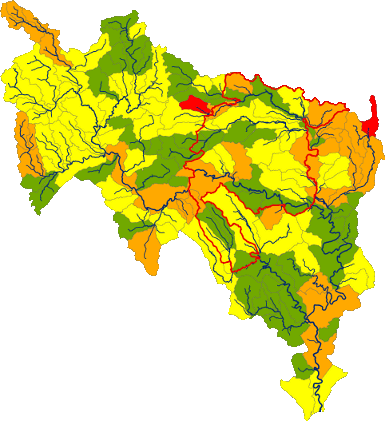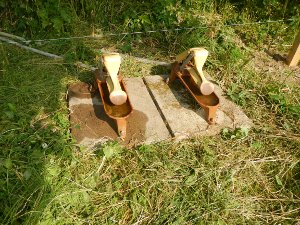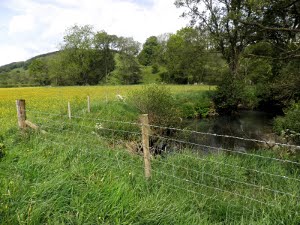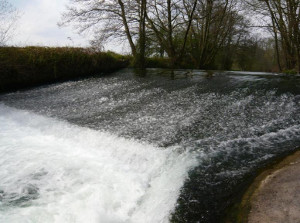Wye (Herefordshire)
Improvement Project
(WHIP2)
WFD Status for the River Wye
and tributaries (project area
outlined in red)


The Wye catchment is currently failing to meet the required
water quality standard as laid out in the European Water
Framework Directive (WFD). Failures can be as a result of
barriers to fish migration, phosphate levels from sewage
treatment works, septic tanks and diffuse pollution
from agriculture. Farming can impact on water quality
in several ways including soil loss (sediment), nutrient
and pesticides losses.
In the WHIP2 project area (the Wye and its tributaries in North and West Herefordshire) there has
been a progressive shift away from permanent pasture and orchards to intensive arable crops - potatoes, winter cereals and soft fruits/poly tunnels, for example. The undulating slopes of the county and the light and medium soil type make many of these crops much more of a risk to rivers than if grown in flatter, eastern counties. On top of that there are increasing demands for water from more intensive livestock and poultry farms.
In the past 10 years there have been signs of an increase in awareness of these issues within the farming community. Pragmatic solutions are available in both the livestock and arable sectors and are being readily taken up. Experience has shown that the farming community is ready to change further, given appropriate levels of support and the provision of cost effective alternatives.
Free advice and grant funding will therefore target these known causes of water body failure on a catchment by catchment basis. In June 2012, we started WHIP2, a 3-year, £1.6m project funded by Defra's Catchment Restoration Fund. The project has two main areas of activity:

1. Agricultural diffuse pollution management
In 2011/12 WUF ran a pilot project on 4 streams in Herefordshire that were failing Good Ecological Status (GES). The intervention of WUF advisors coupled with a quick, easy and flexible grant pool corrected a number of longstanding problems and these waterbodies are now well on the way to attaining GES. This was confirmation that farmers are receptive to our solutions and that by working with them in an entire catchment, real improvements to the streams could be made.

By June 2012, in partnership with EA and Catchment Sensitive Farming (CSF), we prioritised 16 water bodies to receive farm advisory visits. By the end of the project we will have visited nearly 400 farms and produced around 320 'whole farm plans'. These plans will advise of good practice and deliver pragmatic solutions that minimise the risk of that farm contributing to Water Body failure. 80km of riparian fencing will be erected and associated alternative water supplies will be implemented in waterbodies where livestock access is contributing to failure. 96 farm infrastructure improvements will be completed.
In total, the project's target is to improve the status of 33 waterbody elements, bringing an additional 13 of them into Good Ecological Status. 11 others will change from poor status to moderate.

2. Barriers to migration
The Lugg and the Arrow have multiple barriers to migration, some have been there for generations, some more recent. WUF is working on three further easements on both rivers and these will be completed in WHIP2. A crucially important fish pass on the main Lugg at Dayhouse, Kingsland will be completed and if funds are still available, action for some of the smaller tributaries will be included.
Above: Day house weir - a significant barrier at certain flows.
Project Progress
1st November 2012
3 new farm advisors recruited and trained.
Farm advisory work commenced in September with farm visits in upper Arrow, Gladestry, Curl and Tippets catchments.
30th June 2013
-
100 farm plans completed. 80% or better coverage in Upper Arrow, Gladestry, Curl and Tippets catchments. Farm work now moving onto the Honeylake, Lower Arrow, Lugg, Aston Brook, Lye Brook, Ridgemoor Brook and Lime Brook.
-
Erosion risk mapped on SCIMAP and used to help plan operations on all high risk farms.
-
Nutrient management advice for 61 farms.
-
Potato day held and attended by most of the major growers in Herefordshire.
-
7.627km of grant assisted riparian fencing erected with alternative water provided.
-
22 farm infrastructure improvements completed.
-
Weir removed on Pinsley Brook.
-
Easements at Downfield and Mahollam consented and due for completion this summer
-
Owners consent secured and funds committed for an easement on Dayhouse Weir (Lugg). Temporary easement to be fitted if necessary.
1st April 2014
-
170 farm plans completed. SCIMAP proving an essential tool in reducing loss of topsoil.
-
11.5km of grant assisted riparian fencing erected with alternative water sources provided.
-
49 farm infrastructure improvements completed.
-
Trial to establish most effective way of reducing soil loss from maize established. This is in response to the plans for an extra 2,000ha of maize in 2015 to feed the Anaerobic Digester (AD) plants. The trial is in partnership with Cranfield University and will run for a year.
-
Easement completed at Dayhouse weir in time for 2014's salmon run up the Lugg.
-
Monitoring in late 2013 found 4 water bodies in the project area have been lifted to high status for fish. Electrofishing of Lugg and Arrow 2013 showed wide dispersal of salmon (except upper Lugg) including Curl, Hindwell, Pinsley and Knobley brooks.

